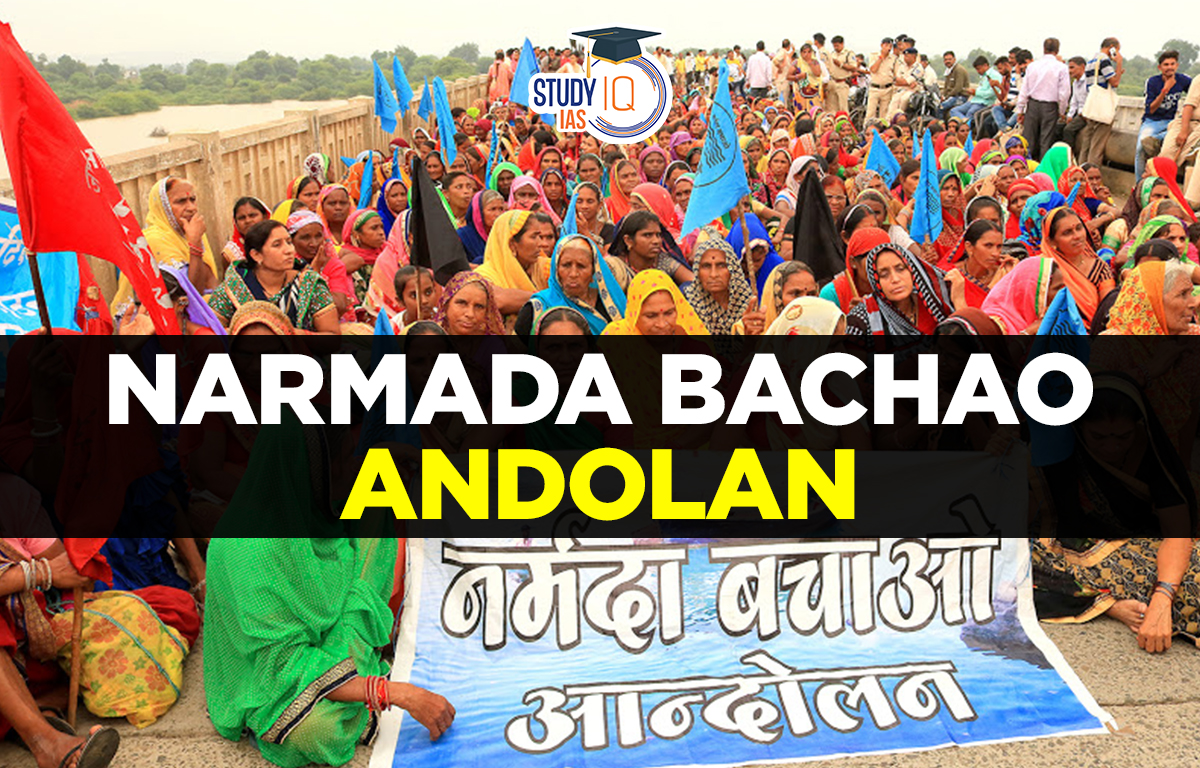Table of Contents
The Narmada Bachao Andolan (NBA) is one of the most influential social movements in India. It was initiated in 1985 by local tribal people, farmers, environmentalists, and human rights activists to protest against the construction of large dams on the Narmada River, particularly the Sardar Sarovar Dam. The movement highlighted issues related to the displacement of people, environmental degradation, and the violation of human rights.
The Narmada River, also known as the Reva, is the fifth-longest river in India and flows through Madhya Pradesh, Maharashtra, and Gujarat. The movement played a key role in shaping India’s environmental policies and raised global awareness about the impact of large dam projects on local communities and ecosystems. One of the key subjects on the UPSC syllabus, “Narmada Bachao Andolan,” and the Save Narmada Movement of 1985 will be covered in this article.
Narmada Bachao Andolan History
The Narmada Bachao Andolan (NBA) is a social movement against the construction of large dams on the Narmada River, primarily the Sardar Sarovar Dam. It emerged as a powerful grassroots movement highlighting the displacement of tribal communities, environmental degradation, and inadequate rehabilitation and resettlement efforts. The NBA gained prominence under the leadership of Medha Patkar, with support from activists like Baba Amte.
Timeline of Major Events
| Year | Event |
|---|---|
| 1961 | The Sardar Sarovar Dam project is proposed to provide water to drought-prone areas of Gujarat, Maharashtra, Madhya Pradesh, and Rajasthan. |
| 1969 | The Narmada Water Disputes Tribunal (NWDT) is established to resolve water-sharing conflicts among the states. |
| 1979 | The NWDT issues a detailed award on water distribution and construction plans, raising concerns about displacement and environmental impact. |
| 1985 | The World Bank sanctions a $450 million loan for the Sardar Sarovar Project, triggering widespread protests. |
| 1987 | Construction work on the Sardar Sarovar Dam begins despite mounting public opposition. |
| 1989 | Medha Patkar formally establishes the Narmada Bachao Andolan (NBA), gaining national and international attention. |
| 1990 | Over 2,000 protestors participate in a five-day sit-in at the Prime Minister’s residence in New Delhi, demanding a review of the project. |
| 1991 | Baba Amte and his seven-member team begin a 22-day hunger strike in protest against the project. |
| 1993 | The Morse Commission Report criticizes the project, leading to the World Bank’s withdrawal from funding. |
| 1994–1999 | Work on the dam is halted due to public and legal pressure. |
| 2000 | The Supreme Court allows conditional continuation of the project with strict guidelines on rehabilitation and resettlement. |
| 2017 | The Sardar Sarovar Dam is inaugurated after completion, with its height raised to 163 meters. |
Narmada Bachao Andolan Causes
The NBA emerged due to a mix of ecological, social, and ethical issues that surround large dam projects. Key reasons include:
- Displacement of Local Communities: The dam projects would lead to large-scale displacement of indigenous and tribal communities residing in the Narmada Valley. Reports suggest that over 200,000 people could lose their homes, livelihood, and cultural heritage.
- Environmental Concerns: The construction of large dams on the Narmada River threatened biodiversity, deforestation, and the ecological balance of the region. Submerging vast areas would destroy forests, displace wildlife, and harm the river’s ecosystem.
- Inadequate Rehabilitation Policies: Displaced populations lacked adequate compensation, rehabilitation, and resettlement programs. In some cases, villagers were resettled in arid lands that could not support farming, their primary source of livelihood.
- Water Logging and Salinity Issues: Experts raised concerns about the potential water-logging and salinity issues that could arise in the irrigated areas, impacting agricultural productivity in the long term.
Narmada Bachao Andolan Feature
- The Narmada, also known as the Reva, is the fifth-longest river in India.
- The government demanded the development of large, medium, and small dams on the river after independence in order to support regional and governmental growth.
- The building of the Sardar Sarovar and Narmada Sagar dams was suggested. The Narmada Valley Development was authorised by the Narmada Water Disputes Tribunal.
- There were 3000 small dams, 135 medium dams, and 30 large dams in the undertaking.
- It was also proposed that the Sardar Sarovar dam’s height be increased.
- In 1985, after the project’s clearance, Medha Patkar and her coworkers made the decision to go to the location.
- She observed that the project’s work was being reviewed according to directives from the Indian government’s Ministry of Environment and Forests.
- In 1987, work on the Sardar Sarovar Dam started.
- The people who were meant to be impacted by the dam’s construction, however, were not the subject of any research. Maybe they received therapy.
- 2000 individuals organised the Narmada Bachao Andolan in May 1990 after observing the state of the populace.
- The PM’s home in New Delhi was the site of a five-day sit-in.
- This action caused PM to reevaluate the Narmada Valley Development Project.
- Additionally, the Narmada People’s Progress Struggle March was started by 6000 men and women in December 1990.
- Over 100 kilometres were marched during this Yatra.
- Baba Amte and his seven-person crew began a 22-day hunger strike in January 1991.
- The Sardar Sarovar Dam’s work finally resumed in 1999.
- It was dedicated in 2017, and construction on it lasted until 2006.
- The project’s height was raised to 163m.
Narmada Bachao Andolan Leaders
- Bhagvati Patidar: A woman who provided unwavering support to the NBA, especially during its formative years
- Sudam Sawanth: An NBA companion who has been associated with the movement for decades
- Mahesh Verma: An NBA companion who has been associated with the movement for decades
- Sanjeev Khode: An NBA companion who has been associated with the movement for decades
- Rajkumar Singh: An NBA companion who has been associated with the movement for decades
Narmada Bachao Andolan Protest Activities
- The opposition to the construction of the Sardar Sarovar Dam on the Narmada River in Gujarat, India’s most western state rapidly developed into a Nongovernmental Organization (NGO) that united farmers, tribal members, environmentalists, and human rights, advocates.
- Along with peaceful protests, protesters have run elaborate media campaigns.
- Examples of such tactics include hunger strikes, famous endorsements in the art and film industries, and others.
- The dam first came under judicial scrutiny in 1985 when Medha Patkar, who was 35 at the time, petitioned the Supreme Court to have it struck down due to poor R&R.
- In May 1990, the Narmada Bachao Andolan organised a 2,000-person, five-day sit-in at Prime Minister V. P. Singh’s home in New Delhi, which persuaded him to reevaluate the project.
- The Narmada Jan Vikas Sangharsh Yatra (Narmada People’s Progress Struggle March), which covered more than 100 kilometers, was started in December 1990 by about 6000 men and women.
- In January 1991, Baba Amte and the seven-person team started a sit-until-you-die hunger strike that endured 22 days.
- Finally, in 2017, the Supreme Court mandated that each family impacted by the Sardar Sarovar project on the Narmada River receive final recompense in the amount of Rs. 60 lacks.
Narmada Bachao Andolan Challenges
The conflict over the allocation of Narmada water between the three states of Gujarat, Maharashtra, and Madhya Pradesh presented another difficulty for the project. A Narmada Water Dispute Tribunal (NWDT) was established in 1969 to address this problem. The NWDT issued its conclusion in 1979 after reviewing the different reports.
The court’s decision states that the dam would release 35 billion cubic metres of water for human usage. Madhya Pradesh would receive 65% of it out of the three states, Gujarat would receive 32%, and Rajasthan and Maharashtra would be qualified for the final 3%.
Role of World Bank
- One of India’s most important multipurpose river valley projects is the Narmada Project.
- The government needs money in order to build the dams.
- The World Bank was thus given permission to start the Narmada Project’s building by the Narmada Water Disputes Tribunal.
- As a consequence, in 1985, the World Bank decided to finance the project.
- It gave $450 million towards building the Sardar Sarovar Dam.
- The World Bank came under more pressure to abandon the initiative as a result of the protest that Medha Patkar organised in Washington, D.C.
- Later, the World Bank declared that it would conduct a project evaluation on its own.
- In 1991, it led to the creation of the Morse Commission for Human Displacement, Environmental Cost, and Dam Construction.
- The World Bank’s involvement was discontinued in 1993.
- The leading Narmada Bachao Movement spokesperson Baba Amte and Medha Patkar both won the Right Livelihood Award in 1991.
- This movement has the backing of well-known figures in film and the arts, as well as rallies, hunger strikes, and legal actions.
- Numerous NGOs, activists, and locals all joined the effort.
- The Narmada Dharangrastha Samiti, based in Maharashtra, was the main backing group.
- Narmada Ghati Nav Nirman Samiti is located in Madhya Pradesh.
- Narmada Asargrastha Samiti, is located in Gujarat.
Narmada Bachao Andolan Importance
The movement’s primary objective was to stop dam construction while displaced people were being fully rehabilitated and relocated. In India’s political history, it was one of the most important mass campaigns against the government to advocate for environmental protection. To prevent their homes and territory from being submerged, the movement brought together different castes.
The campaign was led by indigenous tribal members, farmers, environmentalists, and human rights advocates. International environmental groups supported it. Additionally, the movement supported people in their struggle for their rights and acted as a check on government oppression.
Narmada Bachao Andolan Success
By increasing public knowledge of the environmental, rehabilitation, and relief aspects of Sardar Sarovar and other Narmada projects, the Narmada Bachao Andolan (NBA) has done a great service to the nation. The following are the main achievements of the Narmada Bachao Andolan: The World Bank was kicked out of the Sardar Sarovar project in 1993, and work was stopped between 1994 and 1999. 1999–2001 – The Maheshwar project was abandoned by foreign investors.
Narmada Bachao Andolan UPSC
Narmada Bachao Andolan is an Indian social movement spearheaded by native tribals, farmers, environmentalists, and human rights activists against some large dam projects across the Narmada River, which flows through the states of Gujarat, Madhya Pradesh, and Maharashtra. Students can read all the details related to UPSC by visiting the official website of StudyIQ UPSC online Coaching.


 Indian Rhinoceros, Conservation, Threats...
Indian Rhinoceros, Conservation, Threats...
 Marlin Fish: Species, Features, Appearan...
Marlin Fish: Species, Features, Appearan...
 Great Hornbill (Buceros bicornis): Habit...
Great Hornbill (Buceros bicornis): Habit...





















